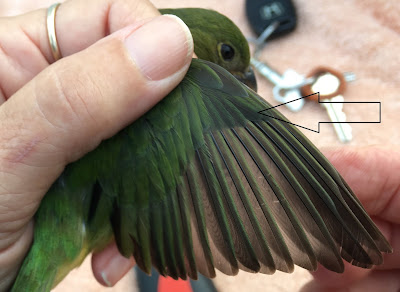We caught 2 new Gray Catbirds and a male Painted Bunting.
We recaptured a female Painted Bunting, a House Wren, a Northern Cardinal, and a Blue Jay.
Migrants were in short supply. Volunteers saw at least three Black-and-white Warblers and they could tell this because two were banded! One on the right leg, one on the left leg, and the third was unbanded.
Maybe the highlight of the day, at least for Nancy Price, was to see this critter as she set up nets!
Fox
Photo by Nancy Price
The recaptured Blue Jay was from September of last year. It felt the need to put its foot in its mouth. Maybe a problem we all have from time to time.
Blue Jay
Photo by Nancy LaFramboise
Our company enjoyed the Gray Catbird that Pete banded. Claudia captured the cat being let out of the bag!
Gray Catbird being weighed
Photo by Claudia Melear
Maybe best of all was the returning Painted Bunting. It is about the 70th one this year that we have documented as returning to the site where they were banded. This one was banded almost a year ago (3/24/15) at Possum Long. There is no place like home, even a winter home. Since she is now a year older and has had a second molt we know this to be a female. Hopefully someone will find more of our banded buntings as they migrate to their summer homes. Kudos to Jane who is working hard using social media to make people aware that there are banded Painted Buntings out there.
Painted Bunting
Photo by Nancy LaFramboise
We caught the House Wren last week during a training session. Recapturing it gave us a chance to show others the wing patterns of a wren in hand. Maybe a bird in the hand is worth two in the bush??
House Wren
Photos by Pete Grannis
Next banding: Tuesday, April 5. Nets go up at 7 am. Remember that constant rain will cancel sessions.



























